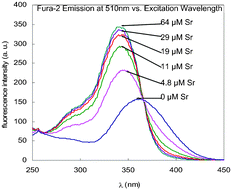This manuscript describes initial progress toward the development of an imaging optical fiber microsphere sensor array for real-time monitoring of Sr2+ in process streams from high-level radioactive waste (HLW) remediation. Fura-2, a fluorescent molecular recognition compound, which displays increased fluorescence intensity upon complexation with divalent cations, was employed as a probe to quantify Sr2+. The solution-based detection of Sr2+ using Fura-2 was investigated in the presence of low Ca2+ concentrations and at high pH and ionic strength. A linear range of 6.7 × 10−7 M to 6.7 × 10−4 M was obtained for Sr2+ in neutral solutions containing trace Ca2+ and 6.7 × 10−8 M and 6.7 × 10−4 M for Sr2+ in high pH, high ionic strength solutions. Additionally, the stability of imaging optical fibers to harsh, high pH conditions was examined. These experiments suggest the fiber surface may need to be modified so that they are stable during the anticipated measurement times required for HLW.
You have access to this article
 Please wait while we load your content...
Something went wrong. Try again?
Please wait while we load your content...
Something went wrong. Try again?


 Please wait while we load your content...
Please wait while we load your content...